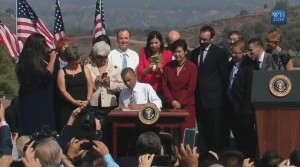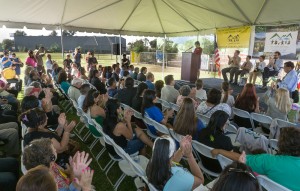In what seems to be lightning speed, last Friday, October 10, 2014, President Barack Obama issued a Presidential Proclamation – Establishment of the San Gabriel Mountains National Monument. The ceremony was held at Bonelli Regional Park, with the San Gabriel Mountains themselves providing a dramatic backdrop for the event. We understand proclamation delivers much of what we expected, with no unexpected surprises. We expect to be pleased by it’s language and intent, and still amazed at how quickly it all happened. Once the final proclamation is posted, we’ll update accordingly.
Though the last two months have seemed quick from our perspective, the effort to bring additional resources and protection to the San Gabriel Mountains has been underway for more than a decade. Since Hilda Solis introduced the legislation to study the San Gabriel Mountains and Watershed in 2002, the area has been the subject of highly organized and focused advocacy efforts from a diverse range of environmental and social groups. Today was a great milestone and achievement not just for those groups, but for all of us who value the forest, its resources, and the opportunities it provides.
We’re especially pleased to see the prominence of recreation in all the later announcements, and the implicit acknowledgement that bicycles and other recreational uses are welcomed and appropriate. We’d like to think it was no accident that the Whitehouse blog post about the signing features a mountain biker as the first picture. We understand the proclamation further protects the mountains, but also protects our access and ability to recreate in them. Its potential to bolster the quality and continuity of our water supply can’t be understated. These mountains are the lungs of the city, the place to go for cleaner air and a clearer mind and a healthier body. And they’ll continue to be so.
There are still many opposed to the National Monument proclamation. The public relations outreach effort was botched from the start, and felt like an afterthought to something that was already well underway. The movement’s momentum was evident even at that poorly executed initial public announcement on August 26, 2014. There had been no public involvement in the process, and that initial announcement was just that, an announcement, not a true public participation event. It was for that reason we thought it best to approach and work with the proponents of the NM, and help make sure that recreational users and conservationists were heard and considered.
By being involved and reaching out early on, engaging with San Gabriel Mountains Forever and their partners, we’re in a better position going forward. The ability to present a unified position from multiple organizations advocating for both recreation and conservation will help these treasured lands meet the needs of everyone. It will help protect where we play.
The previously posted National Monument FAQ’s were developed as a joint project with MWBA, SGMF and much appreciated guidance and expertise from IMBA and The Wilderness Society at the national level. Those FAQ’s all still apply, and we’ll work with those same groups when the management planning process begins. We’ll continue to represent bicyclists’ interests in an advisory role that will help guide the Monument’s management plan development.
The National Monument does not include several areas with heavy recreational activity: the frontcountry slopes of the Crescenta Valley, Altadena, and the San Gabriel Valley. Most of Big Tujunga drainage is also left out, along with the originally proposed areas in San Bernardino County, including Wrightwood and Mount Baldy. At this point we can only surmise that the competing interests of water company holdings, private cabins and inholdings, utility corridors, commercial ski area operations, and extremely heavy visitor use would have been too complex to resolve quickly, and those areas are best left as they are. The Epoch Times reported that it was “to calm fears that it would hurt the area financially.” However, many competing speculative theories have also been rumored.
We, and many of those opposed to the monument, would have appreciated a slower and more methodically executed public process in a number of areas: the boundary definitions, the language of the proclamation, a study of the economic impacts, and the specific rights of and impacts to the public, to permit holders and others affected by the designation. If more time and public outreach had been taken, there would likely have been less opposition–and less suspicion–of the declaration and its impacts to those who live in, work in, recreate in, and love the San Gabriel Mountains. Still, despite how we got here, the end result should bring many benefits.
One of the purported benefits of a National Monument is that it will receive a line item budget, and with that the opportunity for increased funding. At the post-proclamation ceremony, Congresswoman Judy Chu announced that $4.5 million has already been raised for the Monument, including a $3m fund from the National Forest Foundation. Forest Supervisor Tom Contreras told us in conversation that he has already begun hiring additional staff, including cleanup and enforcement staff, to begin in 2015. Under-staffing and under-funding are the biggest hindrances the Forest Service has faced, and the designation seems to make correcting that a priority. Let’s hope those additional resources can be allocated as quickly as the rest of this process has gone, and that the funds for the Monument can free up other resources for the heavily impacted frontcountry areas that were excluded.
What Does This Mean for Mountain Bikers?
Our understanding at this early stage is that nothing on the ground will change in the immediate future. We can continue to ride our bikes on trails, fire roads and paved roads in the forest. We can continue to schedule volunteer trail maintenance. We can continue to enjoy these mountains in the ways we already do. So can everyone else.
The Forest Service must now develop a new management plan for the Monument over the next few years. The plan will specify how they will manage the Monument in accordance with the language and intent of the proclamation. CORBA and MWBA will be closely involved in the process. This is where the entire mountain biking community will also have to remain vigilant and involved. We must SHOW UP and SPEAK UP on any aspect of the plan that affects us, whether positively or negatively. You’ll get alerts when your written comments or attendance at a public meeting is most needed, and we challenge you to respond. The more of us that are united and involved, the better we can participate in the planning process as a group.
As expected the proclamation did not include any new wilderness or other restrictive designations. The Monument status will have no bearing on the outcome of ongoing efforts to expand wilderness areas. We’ll continue monitoring those efforts, and be at the table in those discussions to help ensure our continued access to trails. Our participation in the process so far has helped open that door.
CORBA has developed a great relationship with the Forest Service over the past quarter century. We look forward to continuing to work with the same people and to ride and connect with nature in our same beloved mountains as they transition 346,000 acres of our National Forest into our new National Monument.
When it becomes available, we’ll add the final proclamation language for all to see.







